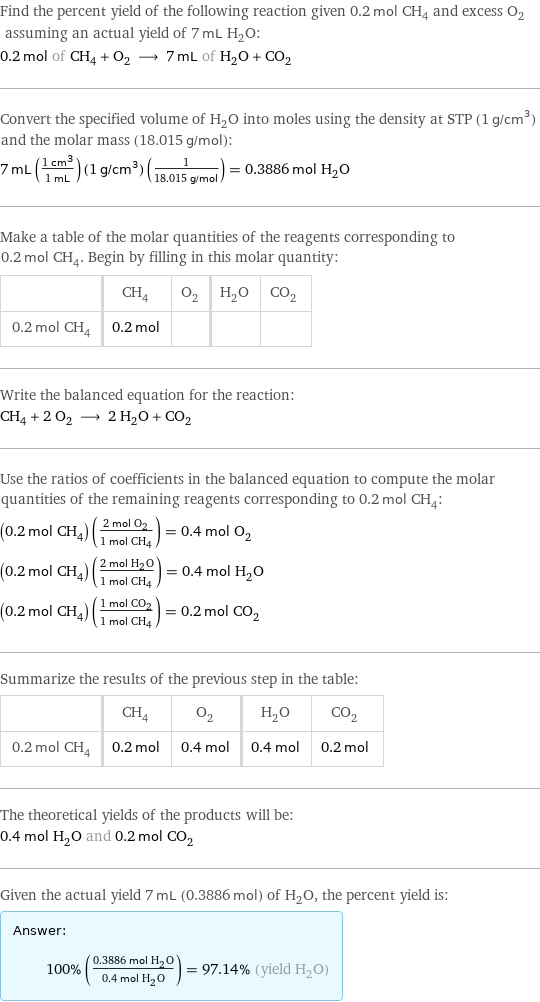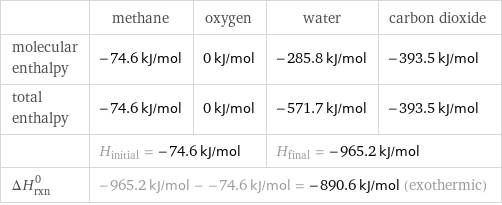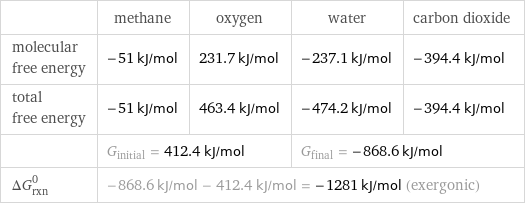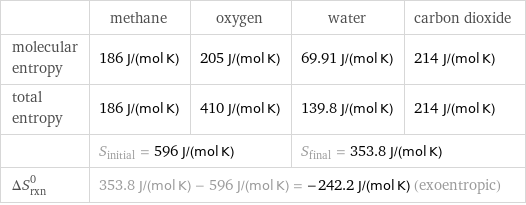Input interpretation

0.200 mol of CH_4 methane + O_2 oxygen ⟶ 7 mL of H_2O water + CO_2 carbon dioxide
Balanced equation

Balance the chemical equation algebraically: CH_4 + O_2 ⟶ H_2O + CO_2 Add stoichiometric coefficients, c_i, to the reactants and products: c_1 CH_4 + c_2 O_2 ⟶ c_3 H_2O + c_4 CO_2 Set the number of atoms in the reactants equal to the number of atoms in the products for C, H and O: C: | c_1 = c_4 H: | 4 c_1 = 2 c_3 O: | 2 c_2 = c_3 + 2 c_4 Since the coefficients are relative quantities and underdetermined, choose a coefficient to set arbitrarily. To keep the coefficients small, the arbitrary value is ordinarily one. For instance, set c_1 = 1 and solve the system of equations for the remaining coefficients: c_1 = 1 c_2 = 2 c_3 = 2 c_4 = 1 Substitute the coefficients into the chemical reaction to obtain the balanced equation: Answer: | | CH_4 + 2 O_2 ⟶ 2 H_2O + CO_2
Stoichiometry

Find the percent yield of the following reaction given 0.2 mol CH_4 and excess O_2 assuming an actual yield of 7 mL H_2O: 0.2 mol of CH_4 + O_2 ⟶ 7 mL of H_2O + CO_2 Convert the specified volume of H_2O into moles using the density at STP (1 g/cm^3) and the molar mass (18.015 g/mol): 7 mL ((1 cm^3)/(1 mL)) (1 g/cm^3) (1/(18.015 g/mol)) = 0.3886 mol H_2O Make a table of the molar quantities of the reagents corresponding to 0.2 mol CH_4. Begin by filling in this molar quantity: | CH_4 | O_2 | H_2O | CO_2 0.2 mol CH_4 | 0.2 mol | | | Write the balanced equation for the reaction: CH_4 + 2 O_2 ⟶ 2 H_2O + CO_2 Use the ratios of coefficients in the balanced equation to compute the molar quantities of the remaining reagents corresponding to 0.2 mol CH_4: (0.2 mol CH_4) ((2 mol O_2)/(1 mol CH_4)) = 0.4 mol O_2 (0.2 mol CH_4) ((2 mol H_2O)/(1 mol CH_4)) = 0.4 mol H_2O (0.2 mol CH_4) ((1 mol CO_2)/(1 mol CH_4)) = 0.2 mol CO_2 Summarize the results of the previous step in the table: | CH_4 | O_2 | H_2O | CO_2 0.2 mol CH_4 | 0.2 mol | 0.4 mol | 0.4 mol | 0.2 mol The theoretical yields of the products will be: 0.4 mol H_2O and 0.2 mol CO_2 Given the actual yield 7 mL (0.3886 mol) of H_2O, the percent yield is: Answer: | | 100% ((0.3886 mol H_2O)/(0.4 mol H_2O)) = 97.14% (yield H_2O)
Structures

+ ⟶ +
Names

methane + oxygen ⟶ water + carbon dioxide
Reaction thermodynamics
Enthalpy

| methane | oxygen | water | carbon dioxide molecular enthalpy | -74.6 kJ/mol | 0 kJ/mol | -285.8 kJ/mol | -393.5 kJ/mol total enthalpy | -74.6 kJ/mol | 0 kJ/mol | -571.7 kJ/mol | -393.5 kJ/mol | H_initial = -74.6 kJ/mol | | H_final = -965.2 kJ/mol | ΔH_rxn^0 | -965.2 kJ/mol - -74.6 kJ/mol = -890.6 kJ/mol (exothermic) | | |
Gibbs free energy

| methane | oxygen | water | carbon dioxide molecular free energy | -51 kJ/mol | 231.7 kJ/mol | -237.1 kJ/mol | -394.4 kJ/mol total free energy | -51 kJ/mol | 463.4 kJ/mol | -474.2 kJ/mol | -394.4 kJ/mol | G_initial = 412.4 kJ/mol | | G_final = -868.6 kJ/mol | ΔG_rxn^0 | -868.6 kJ/mol - 412.4 kJ/mol = -1281 kJ/mol (exergonic) | | |
Entropy

| methane | oxygen | water | carbon dioxide molecular entropy | 186 J/(mol K) | 205 J/(mol K) | 69.91 J/(mol K) | 214 J/(mol K) total entropy | 186 J/(mol K) | 410 J/(mol K) | 139.8 J/(mol K) | 214 J/(mol K) | S_initial = 596 J/(mol K) | | S_final = 353.8 J/(mol K) | ΔS_rxn^0 | 353.8 J/(mol K) - 596 J/(mol K) = -242.2 J/(mol K) (exoentropic) | | |
Equilibrium constant
![Construct the equilibrium constant, K, expression for: CH_4 + O_2 ⟶ H_2O + CO_2 Plan: • Balance the chemical equation. • Determine the stoichiometric numbers. • Assemble the activity expression for each chemical species. • Use the activity expressions to build the equilibrium constant expression. Write the balanced chemical equation: CH_4 + 2 O_2 ⟶ 2 H_2O + CO_2 Assign stoichiometric numbers, ν_i, using the stoichiometric coefficients, c_i, from the balanced chemical equation in the following manner: ν_i = -c_i for reactants and ν_i = c_i for products: chemical species | c_i | ν_i CH_4 | 1 | -1 O_2 | 2 | -2 H_2O | 2 | 2 CO_2 | 1 | 1 Assemble the activity expressions accounting for the state of matter and ν_i: chemical species | c_i | ν_i | activity expression CH_4 | 1 | -1 | ([CH4])^(-1) O_2 | 2 | -2 | ([O2])^(-2) H_2O | 2 | 2 | ([H2O])^2 CO_2 | 1 | 1 | [CO2] The equilibrium constant symbol in the concentration basis is: K_c Mulitply the activity expressions to arrive at the K_c expression: Answer: | | K_c = ([CH4])^(-1) ([O2])^(-2) ([H2O])^2 [CO2] = (([H2O])^2 [CO2])/([CH4] ([O2])^2)](../image_source/906cb5bea1c551541fda11d6fdb795fe.png)
Construct the equilibrium constant, K, expression for: CH_4 + O_2 ⟶ H_2O + CO_2 Plan: • Balance the chemical equation. • Determine the stoichiometric numbers. • Assemble the activity expression for each chemical species. • Use the activity expressions to build the equilibrium constant expression. Write the balanced chemical equation: CH_4 + 2 O_2 ⟶ 2 H_2O + CO_2 Assign stoichiometric numbers, ν_i, using the stoichiometric coefficients, c_i, from the balanced chemical equation in the following manner: ν_i = -c_i for reactants and ν_i = c_i for products: chemical species | c_i | ν_i CH_4 | 1 | -1 O_2 | 2 | -2 H_2O | 2 | 2 CO_2 | 1 | 1 Assemble the activity expressions accounting for the state of matter and ν_i: chemical species | c_i | ν_i | activity expression CH_4 | 1 | -1 | ([CH4])^(-1) O_2 | 2 | -2 | ([O2])^(-2) H_2O | 2 | 2 | ([H2O])^2 CO_2 | 1 | 1 | [CO2] The equilibrium constant symbol in the concentration basis is: K_c Mulitply the activity expressions to arrive at the K_c expression: Answer: | | K_c = ([CH4])^(-1) ([O2])^(-2) ([H2O])^2 [CO2] = (([H2O])^2 [CO2])/([CH4] ([O2])^2)
Rate of reaction
![Construct the rate of reaction expression for: CH_4 + O_2 ⟶ H_2O + CO_2 Plan: • Balance the chemical equation. • Determine the stoichiometric numbers. • Assemble the rate term for each chemical species. • Write the rate of reaction expression. Write the balanced chemical equation: CH_4 + 2 O_2 ⟶ 2 H_2O + CO_2 Assign stoichiometric numbers, ν_i, using the stoichiometric coefficients, c_i, from the balanced chemical equation in the following manner: ν_i = -c_i for reactants and ν_i = c_i for products: chemical species | c_i | ν_i CH_4 | 1 | -1 O_2 | 2 | -2 H_2O | 2 | 2 CO_2 | 1 | 1 The rate term for each chemical species, B_i, is 1/ν_i(Δ[B_i])/(Δt) where [B_i] is the amount concentration and t is time: chemical species | c_i | ν_i | rate term CH_4 | 1 | -1 | -(Δ[CH4])/(Δt) O_2 | 2 | -2 | -1/2 (Δ[O2])/(Δt) H_2O | 2 | 2 | 1/2 (Δ[H2O])/(Δt) CO_2 | 1 | 1 | (Δ[CO2])/(Δt) (for infinitesimal rate of change, replace Δ with d) Set the rate terms equal to each other to arrive at the rate expression: Answer: | | rate = -(Δ[CH4])/(Δt) = -1/2 (Δ[O2])/(Δt) = 1/2 (Δ[H2O])/(Δt) = (Δ[CO2])/(Δt) (assuming constant volume and no accumulation of intermediates or side products)](../image_source/bb7febd82e6195753ffaf06eddaa03dc.png)
Construct the rate of reaction expression for: CH_4 + O_2 ⟶ H_2O + CO_2 Plan: • Balance the chemical equation. • Determine the stoichiometric numbers. • Assemble the rate term for each chemical species. • Write the rate of reaction expression. Write the balanced chemical equation: CH_4 + 2 O_2 ⟶ 2 H_2O + CO_2 Assign stoichiometric numbers, ν_i, using the stoichiometric coefficients, c_i, from the balanced chemical equation in the following manner: ν_i = -c_i for reactants and ν_i = c_i for products: chemical species | c_i | ν_i CH_4 | 1 | -1 O_2 | 2 | -2 H_2O | 2 | 2 CO_2 | 1 | 1 The rate term for each chemical species, B_i, is 1/ν_i(Δ[B_i])/(Δt) where [B_i] is the amount concentration and t is time: chemical species | c_i | ν_i | rate term CH_4 | 1 | -1 | -(Δ[CH4])/(Δt) O_2 | 2 | -2 | -1/2 (Δ[O2])/(Δt) H_2O | 2 | 2 | 1/2 (Δ[H2O])/(Δt) CO_2 | 1 | 1 | (Δ[CO2])/(Δt) (for infinitesimal rate of change, replace Δ with d) Set the rate terms equal to each other to arrive at the rate expression: Answer: | | rate = -(Δ[CH4])/(Δt) = -1/2 (Δ[O2])/(Δt) = 1/2 (Δ[H2O])/(Δt) = (Δ[CO2])/(Δt) (assuming constant volume and no accumulation of intermediates or side products)
Chemical names and formulas

| methane | oxygen | water | carbon dioxide formula | CH_4 | O_2 | H_2O | CO_2 name | methane | oxygen | water | carbon dioxide IUPAC name | methane | molecular oxygen | water | carbon dioxide